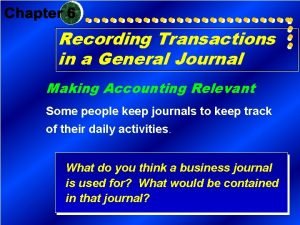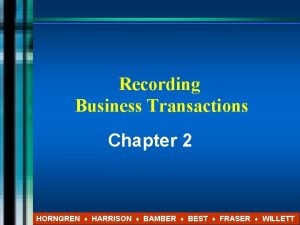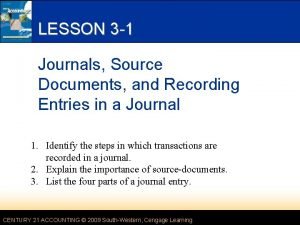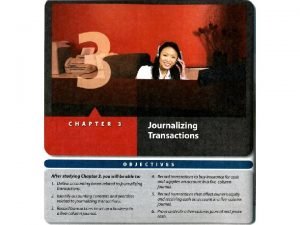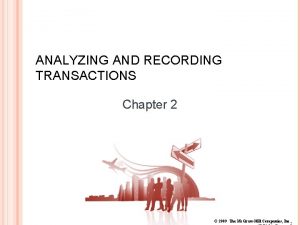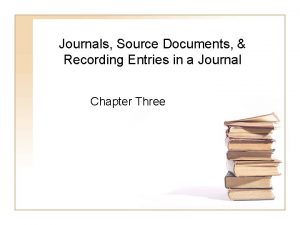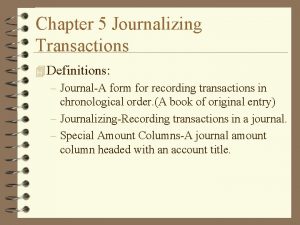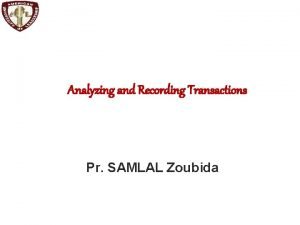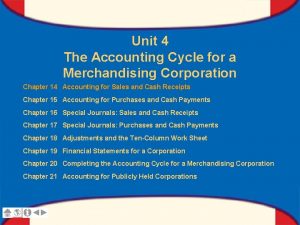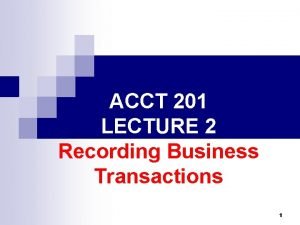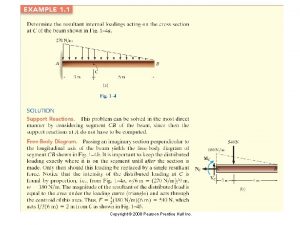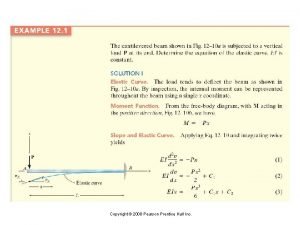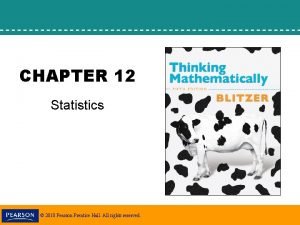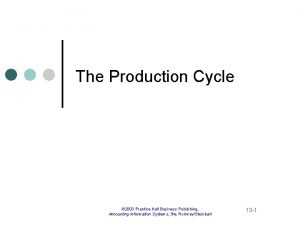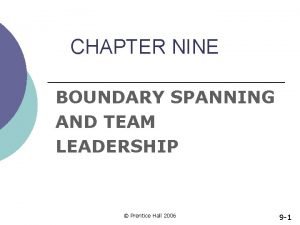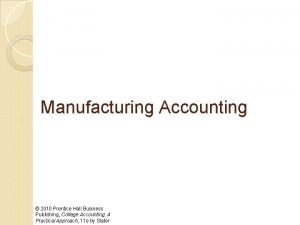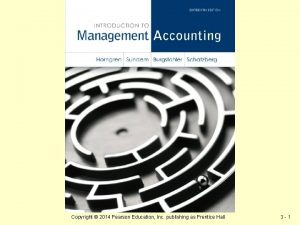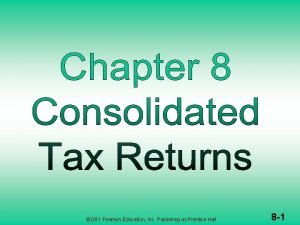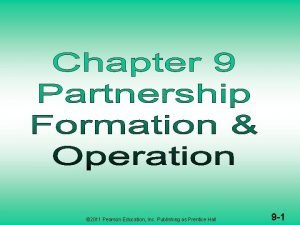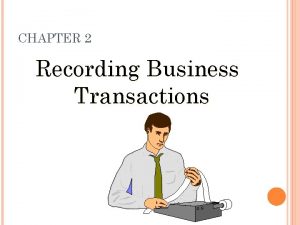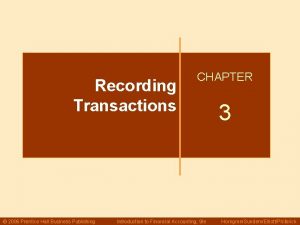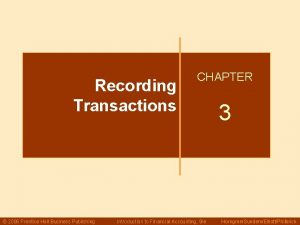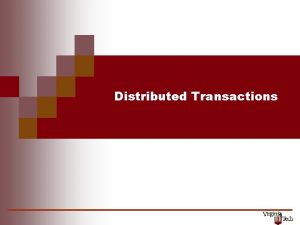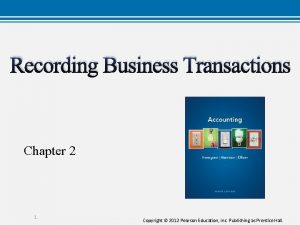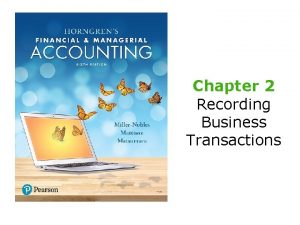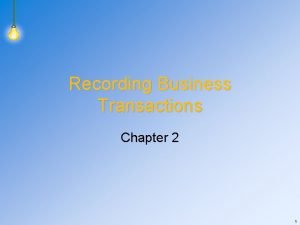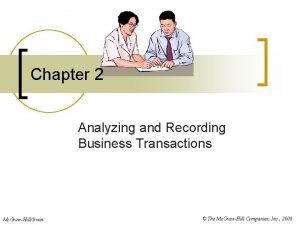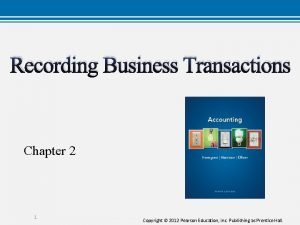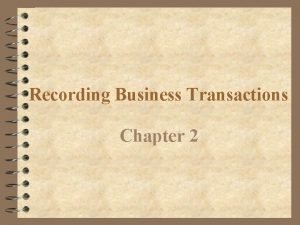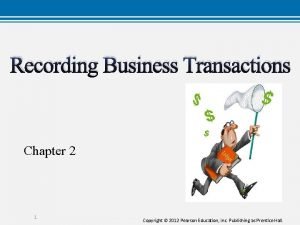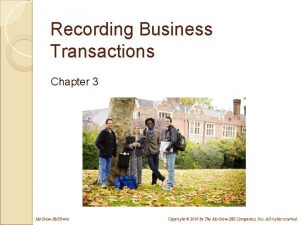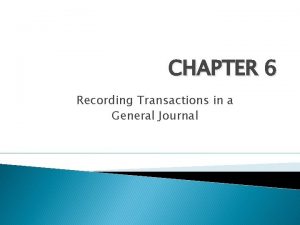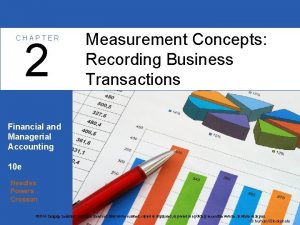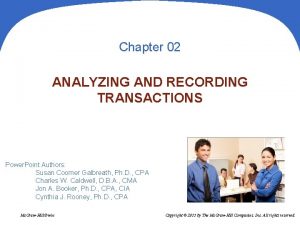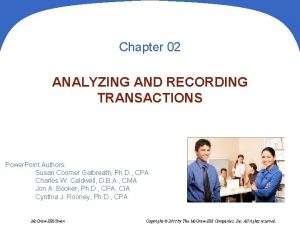3 1 Chapter 3 Recording Transactions 2002 Prentice














































- Slides: 46

3 -1 Chapter 3 Recording Transactions © 2002 Prentice Hall Business Publishing Introduction to Financial Accounting, 8 th Edition Horngren, Sundem, and Elliott

3 -2 Learning Objectives After studying this chapter, you should be able to: u Use double-entry accounting. u Analyze and journalize transactions. u Post journal entries to the ledgers. u Prepare and use a trial balance. u Close revenue and expense accounts and update retained income. © 2002 Prentice Hall Business Publishing Introduction to Financial Accounting, 8 th Edition Horngren, Sundem, and Elliott

3 -3 Learning Objectives After studying this chapter, you should be able to: u Correct erroneous journal entries and describe how errors affect accounts. u Use T-accounts to analyze accounting relationships. u Explain how computers have transformed processing of accounting data. © 2002 Prentice Hall Business Publishing Introduction to Financial Accounting, 8 th Edition Horngren, Sundem, and Elliott

The Double-Entry Accounting System 3 -4 u Some businesses enter into thousands of transactions daily or even hourly. • Accountants must carefully keep track of and record these transactions in a systematic manner. u Accountants use a double-entry accounting system in which at least two accounts are always affected by each transaction. © 2002 Prentice Hall Business Publishing Introduction to Financial Accounting, 8 th Edition Horngren, Sundem, and Elliott

The Double-Entry Accounting System 3 -5 u Each transaction must still be analyzed to determine which accounts are involved, whether the accounts increase or decrease, and how much the balance will change. u The balance sheet equation can be used for this analysis, but with so many transactions, this is not realistic. • In practice, accountants use ledgers. © 2002 Prentice Hall Business Publishing Introduction to Financial Accounting, 8 th Edition Horngren, Sundem, and Elliott

3 -6 Ledger Accounts u Ledger - a group of related accounts kept current in a systematic manner • Think of a ledger as a book with page for each account. • The ledger is a company’s “books. ” one Ledger u General ledger - the collection of accounts that accumulates the amounts reported in the major financial statements © 2002 Prentice Hall Business Publishing Introduction to Financial Accounting, 8 th Edition Horngren, Sundem, and Elliott

3 -7 Ledger Accounts u. A simplified version of a ledger account is called the T-account. • They allow us to capture the essence of the accounting process without having to worry about too many details. • The account is divided into two sides for recording increases and decreases in the accounts. Account Title Left Side © 2002 Prentice Hall Business Publishing Right Side Introduction to Financial Accounting, 8 th Edition Horngren, Sundem, and Elliott

3 -8 Ledger Accounts u Balance - difference between total left-side amounts and total right-side amounts at any particular time • Assets have left-side balances. – Increased by entries to the left side – Decreased by entries to the right side • Liabilities and Owners’ Equity have right-side balances. – Decreased by entries to the left side – Increased by entries to the right side © 2002 Prentice Hall Business Publishing Introduction to Financial Accounting, 8 th Edition Horngren, Sundem, and Elliott

3 -9 Ledger Accounts u T-accounts and the balance sheet equation: Assets = Liabilities + Owners’ Equity Assets Increases Decreases Liabilities Decreases Increases Owners’ Equity Decreases © 2002 Prentice Hall Business Publishing Increases Introduction to Financial Accounting, 8 th Edition Horngren, Sundem, and Elliott

3 - 10 Debits and Credits u Debit (dr. ) - an entry or balance on the left side of an account u Credit (cr. ) - an entry or balance on the right side of an account u Remember: • Debit is always the left side! • Credit is always the right side! © 2002 Prentice Hall Business Publishing Introduction to Financial Accounting, 8 th Edition Horngren, Sundem, and Elliott

3 - 11 The Recording Process u The sequence of steps in recording transactions: Transactions Financial Statements © 2002 Prentice Hall Business Publishing Documentation Journal Trial Balance Ledger Introduction to Financial Accounting, 8 th Edition Horngren, Sundem, and Elliott

3 - 12 The Recording Process u The process starts with source documents, which are the supporting original records of any transaction. • Examples are sales slips or invoices, check stubs, purchase orders, receiving reports, and cash receipt slips. © 2002 Prentice Hall Business Publishing Introduction to Financial Accounting, 8 th Edition Horngren, Sundem, and Elliott

3 - 13 The Recording Process u In the second step, an analysis of the transaction is placed in the book of original entry, which is a chronological record of how the transactions affect the balances of applicable accounts. • The most common example is the general journal - a diary of all events (transactions) in an entity’s life. © 2002 Prentice Hall Business Publishing Introduction to Financial Accounting, 8 th Edition Horngren, Sundem, and Elliott

3 - 14 The Recording Process u In the third step, transactions are entered into the ledger. • Remember that a transaction is not entered in just one place; it must be entered in each account that it affects. • Depending on the nature of the organization, analysis of the transactions could occur continuously or periodically. © 2002 Prentice Hall Business Publishing Introduction to Financial Accounting, 8 th Edition Horngren, Sundem, and Elliott

3 - 15 The Recording Process u The fourth step includes the preparation of the trial balance, which is a simple listing of all accounts in the general ledger with their balances. • Aids in verifying accuracy and in preparing the financial statements • Prepared periodically as necessary © 2002 Prentice Hall Business Publishing Introduction to Financial Accounting, 8 th Edition Horngren, Sundem, and Elliott

3 - 16 The Recording Process u In the final step, the financial statements are prepared. • Financial statements are prepared each quarter of the year for publicly traded companies. • Other companies prepare December 2002 financial statements at various other intervals to meet the needs of their users. © 2002 Prentice Hall Business Publishing Introduction to Financial Accounting, 8 th Edition Horngren, Sundem, and Elliott

3 - 17 Journalizing Transactions u Journalizing - the process of entering transactions into the journal u Journal entry - an analysis of the effects of a transaction on the accounts, usually accompanied by an explanation of the transaction • This analysis identifies the accounts to be debited and credited. © 2002 Prentice Hall Business Publishing Introduction to Financial Accounting, 8 th Edition Horngren, Sundem, and Elliott

3 - 18 Journalizing Transactions u The conventional form for journal entries includes the following: • The date and identification number of the entry • The accounts affected an explanation of the transaction • The posting reference, which is the number assigned to each account affected by the transaction • The amounts that the accounts are to be debited and credited © 2002 Prentice Hall Business Publishing Introduction to Financial Accounting, 8 th Edition Horngren, Sundem, and Elliott

3 - 19 Journalizing Transactions u The conventional form for recording in the general journal: Date 2001 12/31 2002 1/2 Entry No. 1 2 3 Accounts and Explanations Post. Ref Debit Credit Cash Paid-in capital 100 300 400, 000 Cash Note payable 100 202 100, 000 Merchandise inventory Cash 130 100 150, 000 © 2002 Prentice Hall Business Publishing Introduction to Financial Accounting, 8 th Edition 400, 000 150, 000 Horngren, Sundem, and Elliott

3 - 20 Chart of Accounts u Chart of accounts - a numbered or coded list of all account titles used to record transactions Account Number 100 120 130 140 170 A Account Title Cash Accounts receivable Merchandise inventory Prepaid rent Store equipment Accumulated depreciation © 2002 Prentice Hall Business Publishing Account Number 203 300 400 Account Title 202 Notes payable Accounts payable Paid-in capital Retained income 500 Sales revenue 600 Cost of goods sold 601 Rent expense 602 Depreciation expense Introduction to Financial Accounting, 8 th Edition Horngren, Sundem, and Elliott

Posting Transactions to the Ledger 3 - 21 u Posting - transferring of amounts from the journal to the appropriate accounts in the ledger • Dates, explanations, and journal references are provided in detail on paper formatted with special columns. © 2002 Prentice Hall Business Publishing Introduction to Financial Accounting, 8 th Edition Horngren, Sundem, and Elliott

Posting Transactions to the Ledger 3 - 22 u Cross-referencing - the process of numbering or otherwise specifically identifying each journal entry and each posting • Transactions are often posted to several different accounts, but cross-referencing allows users to find all components of a transaction in the ledger no matter where they start. • Cross-referencing also allows auditors to find and correct errors. © 2002 Prentice Hall Business Publishing Introduction to Financial Accounting, 8 th Edition Horngren, Sundem, and Elliott

3 - 23 Running Balance Column u Ledgers do not always look like T-accounts. u One format is much like the check register in your checkbook and provides columns for: • • • The date An explanation A journal reference Debits Credits The balance © 2002 Prentice Hall Business Publishing Introduction to Financial Accounting, 8 th Edition Horngren, Sundem, and Elliott

3 - 24 Running Balance Column u The running balance provides a status report for an account at a glance at any given point in time. CASH Date Explanation 2001 12/31 2002 1/2 © 2002 Prentice Hall Business Publishing Account No. 100 Journal Ref. Debit 1 2 400, 000 100, 000 3 Introduction to Financial Accounting, 8 th Edition Credit Balance 400, 000 500, 000 150, 000 350, 000 Horngren, Sundem, and Elliott

Analyzing, Journalizing, and Posting Transactions u Types 3 - 25 of journal entries: • Simple entry - an entry for a transaction that affects only two accounts • Compound entry - an entry for a transaction that affects more than two accounts u Remember: whether the entry is simple or compound, the debits (left side) and credits (right side) must always equal. © 2002 Prentice Hall Business Publishing Introduction to Financial Accounting, 8 th Edition Horngren, Sundem, and Elliott

Revenue and Expense Transactions 3 - 26 u Retained Income is merely accumulated revenues less expenses, but we cannot just increase or decrease the Retained Income account directly. • This would make preparing the income statement very difficult u By accumulating revenues and expenses separately, a more meaningful income statement can be easily prepared. © 2002 Prentice Hall Business Publishing Introduction to Financial Accounting, 8 th Edition Horngren, Sundem, and Elliott

Revenue and Expense Transactions 3 - 27 u Revenue and expense accounts are a part of Retained Income Decrease Expense Increase Revenue Debit Credit Increase © 2002 Prentice Hall Business Publishing Introduction to Financial Accounting, 8 th Edition Horngren, Sundem, and Elliott

Revenue and Expense Transactions u Summary 3 - 28 of revenue and expense transactions: • A credit to a revenue increases the revenue and increases Retained Income. • A debit to a revenue decreases the revenue and decreases Retained Income. • A credit to an expense decreases the expense and increases Retained Income. • A debit to an expense increases the expense and decreases Retained Income. © 2002 Prentice Hall Business Publishing Introduction to Financial Accounting, 8 th Edition Horngren, Sundem, and Elliott

Revenue and Expense Transactions 3 - 29 u Keeping revenues and expenses in separate accounts makes the preparation of the income statement easier. • The income statement provides a detailed explanation of how operations caused the balance of Retained Income shown on the balance sheet to change from the beginning of the year to the end of the year. © 2002 Prentice Hall Business Publishing Introduction to Financial Accounting, 8 th Edition Horngren, Sundem, and Elliott

Prepaid Expense and Depreciation Transactions 3 - 30 u Prepaid expenses relate to assets having useful lives that will expire sometime in the future. • The expiration, or using up, of those assets is an expense. u With depreciation, a new account, Accumulated Depreciation, is introduced. • Accumulated depreciation - the cumulative sum of all depreciation recognized since the date of acquisition of a particular asset © 2002 Prentice Hall Business Publishing Introduction to Financial Accounting, 8 th Edition Horngren, Sundem, and Elliott

Prepaid Expense and Depreciation Transactions 3 - 31 u An accounts such as Accumulated Depreciation is called a contra account, which is a separate but related account that offsets or is a deduction from a companion account. u Book value - the balance of an account, net of any contra accounts (a. k. a net book value, carrying amount, or carrying value) • The book value of an asset is its acquisition cost minus accumulated depreciation. © 2002 Prentice Hall Business Publishing Introduction to Financial Accounting, 8 th Edition Horngren, Sundem, and Elliott

A Note on Accumulated Depreciation 3 - 32 u Why use accumulated depreciation? Why not just reduce the asset account as it expires? • Accountants want the acquisition cost to remain on the books, so the asset must be “reduced” in some manner. • Also, the acquisition cost of the asset is a reliable and objective number, whereas accumulated depreciation is an estimate of the allocation of the cost of that asset over the period that it benefits. © 2002 Prentice Hall Business Publishing Introduction to Financial Accounting, 8 th Edition Horngren, Sundem, and Elliott

Transactions in the Journal and Ledger u Some 3 - 33 details to remember: • Do not use dollar signs in either the journal or the ledger. • Do not use negative numbers. The effect on the account is conveyed by the side (debit or credit) on which the number appears. • For ledgers that do not have a running balance (such as T-accounts), the balances may be updated from time to time. © 2002 Prentice Hall Business Publishing Introduction to Financial Accounting, 8 th Edition Horngren, Sundem, and Elliott

3 - 34 Preparing the Trial Balance u Once all transactions have been posted to the ledger, a trial balance is prepared. u Trial balance - a list of all of the accounts with their balances • It is prepared as a test or check before continuing the recording process. © 2002 Prentice Hall Business Publishing Introduction to Financial Accounting, 8 th Edition Horngren, Sundem, and Elliott

3 - 35 Preparing the Trial Balance u The purposes of the trial balance: • To help check on accuracy of posting by proving whether the total debits equal the total credits • To establish a convenient summary of balances in all accounts for the preparation of formal financial statements © 2002 Prentice Hall Business Publishing Introduction to Financial Accounting, 8 th Edition Horngren, Sundem, and Elliott

3 - 36 Preparing the Trial Balance u The trial balance is usually prepared with the balance sheet accounts first, followed by the income statement accounts. u An Account Number 100 130 202 300 example of a short trial balance: Account Title Cash Merchandise inventory Note payable Paid-in capital © 2002 Prentice Hall Business Publishing Debit Credit $350, 000 150, 000 $500, 000 $100, 000 400, 000 $500, 000 =================== Introduction to Financial Accounting, 8 th Edition Horngren, Sundem, and Elliott

Deriving Financial Statements from the Trial Balance 3 - 37 u The trial balance is the starting point for the preparation of the balance sheet and the income statement. • The income statement accounts are summarized in a single account called Net Income, which becomes part of Retained Income in the balance sheet. • The trial balance shows the beginning balance in Retained Income because no changes have actually been made to the account during the year. © 2002 Prentice Hall Business Publishing Introduction to Financial Accounting, 8 th Edition Horngren, Sundem, and Elliott

Deriving Financial Statements from the Trial Balance 3 - 38 u Note that a trial balance may balance even when errors were made in recording or posting. • A transaction may be recorded as different amounts in two different accounts. • A transaction may be recorded in a wrong account. u In both situations, the total debits will still equal total credits on the trial balance. Dr. = Cr. © 2002 Prentice Hall Business Publishing Introduction to Financial Accounting, 8 th Edition Horngren, Sundem, and Elliott

3 - 39 Closing the Accounts u Once the financial statements are prepared, the ledger accounts must be prepared to record the next period’s transactions. This process is called closing the books. • The balances in all “temporary” stockholders’ equity accounts are transferred to a “permanent” stockholders’ equity account. • The revenue and expense accounts are “reset” to zero and the current net income is transferred to Retained Income. © 2002 Prentice Hall Business Publishing Introduction to Financial Accounting, 8 th Edition Horngren, Sundem, and Elliott

3 - 40 Closing the Accounts u The Closing Process: • The revenue accounts are closed to Income Summary in the first entry. • The expense accounts are closed to Income Summary in the second entry. • The amount of Net Income (revenues - expenses) is then transferred from Income Summary to Retained Income. © 2002 Prentice Hall Business Publishing Introduction to Financial Accounting, 8 th Edition Horngren, Sundem, and Elliott

3 - 41 Effects of Errors u When a journal entry contains an error, it can be erased or crossed out only if the error is detected before the entry is posted to the ledgers. u If the error is detected after posting, a correcting entry must be made. • The correcting entry counteracts the incorrect entry and assures that the correct account is debited or credited for the proper amount. © 2002 Prentice Hall Business Publishing Introduction to Financial Accounting, 8 th Edition Horngren, Sundem, and Elliott

Some Errors Are Counterbalanced 3 - 42 u Some errors are counterbalanced by offsetting errors in the next accounting period. • Errors misstate net income in both periods, but by the end of the second period, the errors offset each other. • Errors misstate the balance sheet of the first year, not the second year because the errors offset each other. u Errors that are not counterbalanced will keep the balance sheet incorrect until correcting entries are made. © 2002 Prentice Hall Business Publishing Introduction to Financial Accounting, 8 th Edition Horngren, Sundem, and Elliott

3 - 43 Incomplete Records u Accountants must sometimes “fill in the blanks” when accounting records are lost, stolen, or destroyed. • T-accounts can help to recreate and calculate unknown amounts. – The accountant must understand the account and the amounts that flow through it in order to determine unknown amounts. • This process can become extremely complicated when many accounts are used. © 2002 Prentice Hall Business Publishing Introduction to Financial Accounting, 8 th Edition Horngren, Sundem, and Elliott

3 - 44 Data Processing and Computers u Data processing - the procedures used to record, analyze, store, and report on chosen activities • An accounting system is one type of data processing system. • Accounting systems are now likely to be computerized, but regardless of format, information still must be entered. © 2002 Prentice Hall Business Publishing Introduction to Financial Accounting, 8 th Edition Horngren, Sundem, and Elliott

3 - 45 Data Processing and Computers u Advantages to computerized systems: • Managers can get daily financial reports. • Employees can enter transactions into a terminal, such as a cash register, and the computer will perform many tasks (update inventory, perform credit checks, and prepare monthly statements for mailing to customers). • The computer can automatically record each transaction as soon as it happens thereby reducing much of the paperwork and data processing costs. © 2002 Prentice Hall Business Publishing Introduction to Financial Accounting, 8 th Edition Horngren, Sundem, and Elliott

3 - 46 Introduction to Financial Accounting 8 th Edition Power. Point Presentation Developed by: Eddie Metrejean, MTAX, CPA University of Mississippi Images provided by New Vision Technology 1 -800 -387 -0732 nvtech. com © 2002 Prentice Hall Business Publishing Introduction to Financial Accounting, 8 th Edition Horngren, Sundem, and Elliott
 Problem 6-2 recording business transactions
Problem 6-2 recording business transactions Problem 6-2 recording business transactions
Problem 6-2 recording business transactions A form describing the goods or services sold
A form describing the goods or services sold A form for recording transactions in chronological order
A form for recording transactions in chronological order General journal example
General journal example Analyzing and recording transactions
Analyzing and recording transactions 5-1 on your own p.128 answers accounting
5-1 on your own p.128 answers accounting Source documents
Source documents A form for recording transactions in chronological order
A form for recording transactions in chronological order Chapter 3 journalizing transactions
Chapter 3 journalizing transactions Part three journalizing transactions
Part three journalizing transactions Analyzing and recording transactions
Analyzing and recording transactions 4. part four—analyzing sales and cash receipts
4. part four—analyzing sales and cash receipts Which sequence correctly summarizes the accounting process?
Which sequence correctly summarizes the accounting process? What is an ode
What is an ode Copyright 2008
Copyright 2008 Pearson prentice hall
Pearson prentice hall 2008 pearson prentice hall inc
2008 pearson prentice hall inc 2005 pearson prentice hall inc
2005 pearson prentice hall inc Pearson prentice hall
Pearson prentice hall Prentice hall inc
Prentice hall inc Prentice hall careers
Prentice hall careers Prentice hall america pathways to the present
Prentice hall america pathways to the present Prentice hall publishing
Prentice hall publishing Jules prentice
Jules prentice Prentice hall publishing
Prentice hall publishing Regula falsi method formula
Regula falsi method formula Prentice hall african american history
Prentice hall african american history Prentice hall physical science concepts in action
Prentice hall physical science concepts in action Pearson education inc publishing as pearson prentice hall
Pearson education inc publishing as pearson prentice hall Joshua prentice
Joshua prentice Prentice boundaries
Prentice boundaries Ocean fisheries
Ocean fisheries Pearson prentice hall
Pearson prentice hall 2005 pearson prentice hall inc
2005 pearson prentice hall inc Prentice's rule formula
Prentice's rule formula Biblical evolution
Biblical evolution Pearson education inc publishing as pearson prentice hall
Pearson education inc publishing as pearson prentice hall Phylum arthropoda common name
Phylum arthropoda common name Dennis prentice
Dennis prentice Prentice hall business publishing
Prentice hall business publishing Pearson education inc. publishing as prentice hall
Pearson education inc. publishing as prentice hall Pearson education inc. publishing as prentice hall
Pearson education inc. publishing as prentice hall Pearson education inc publishing as pearson prentice hall
Pearson education inc publishing as pearson prentice hall Chapter 4 job costing
Chapter 4 job costing 2011 pearson education inc
2011 pearson education inc Pearson education inc. publishing as prentice hall
Pearson education inc. publishing as prentice hall
